Masked lapwing
| Masked lapwing | |
|---|---|
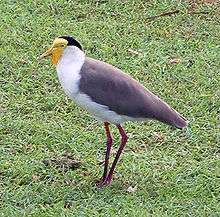 | |
 | |
| V. m. miles (above) V. m. novaehollandiae (below) | |
| Scientific classification | |
| Kingdom: | Animalia |
| Phylum: | Chordata |
| Class: | Aves |
| Order: | Charadriiformes |
| Family: | Charadriidae |
| Genus: | Vanellus |
| Species: | V. miles |
| Binomial name | |
| Vanellus miles (Boddaert, 1783) | |
| Subspecies | |
| |
| Synonyms | |
|
Hoplopterus miles (Boddaert, 1783) | |
The masked lapwing (Vanellus miles), also known as the masked plover and often called the spur-winged plover or just plover in its native range, is a large, common and conspicuous bird native to Australia, particularly the northern and eastern parts of the continent, New Zealand and New Guinea. It spends most of its time on the ground searching for food such as insects and worms and has several distinctive calls. There are two subspecies; the southern novaehollandiae has distinctive black markings on the shoulder and side of the chest, and is sometimes recognized as a separate species, the black-shouldered lapwing (Vanellus novaehollandiae).
These brown-black, white and yellow plovers are common in Australian fields and open land. They should not be confused with the much smaller, brownish, sea-shore, sand-nesting Hooded Plover which is also called the Hooded Dotterel (Thinornis rubicollis).[2]
Taxonomy
The masked lapwing was originally described by the Dutch naturalist Pieter Boddaert in 1783 and given the binomial name Tringa miles.[3][4][lower-alpha 1]
Two subspecies are usually recognised:[6]
- V. m. miles (Boddaert, 1783) - Coastal New Guinea, Aru Islands, northern Australia
- V. m. novaehollandiae Stephens, 1819 - southern Australia, New Zealand
The Handbook of Birds of the World treats V. m. novaehollandiae as a separate species, the black-shouldered lapwing (Vanellus novaehollandiae), even though the two subspecies intergrade in northern Queensland and the Lake Eyre basin.[7][8]
Description
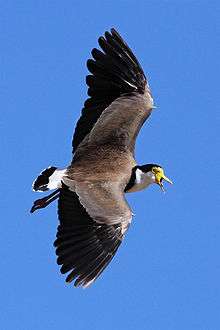
The masked lapwing is the largest representative of the family Charadriidae. It measures from 30 to 37 cm (12 to 15 in) in length and has a wingspan of 75–85 cm (30–33 in). The nominate subspecies (V. m. miles) weighs 191–300 g (6.7–10.6 oz), while the southern race (V. m. novaehollandiae) is larger and weighs 296–412 g (10.4–14.5 oz).[7][8] The subspecies from northern Australia and New Guinea (V. m. miles) has an all-white neck and large yellow wattles with the male having a distinctive mask and larger wattles. The subspecies found in the southern and eastern states of Australia and in New Zealand (V. m. novaehollandiae), and often locally called the spur-winged plover, has a black neck-stripe and smaller wattles. (Note that the northern-hemisphere spur-winged plover is a different bird.)
The birds have a wide range of calls which can be heard at any time of the day or night: the warning call, a loud defending call, courtship calls, calls to its young, and others. Since this bird lives on the ground it is always alert and even though it rests it never sleeps properly.
Distribution and habitat
Masked lapwings are most common around the edges of wetlands and in other moist, open environments, but are adaptable and can often be found in surprisingly arid areas.[9] They can also be found on beaches and coastlines. Vanellus miles novaehollandiae spread naturally to Southland, New Zealand in the 1930s and has now spread throughout New Zealand, where it is recognised as a self-introduced native and known as the spur-winged plover.[10]
Behaviour
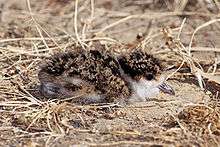

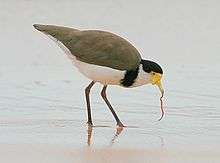
Masked lapwings are shy and harmless in summer and autumn but are best known for their bold nesting habits, being quite prepared to make a nest on almost any stretch of open ground, including suburban parks and gardens, school ovals, and even supermarket carparks and flat rooftops. They can be particularly dangerous at airports where their reluctance to move from their nesting area – even for large aircraft – has resulted in several bird strikes.[11] Breeding usually happens after winter solstice (June 21), but sometimes before. The nesting pair defends their territory against all intruders by calling loudly, spreading their wings, and then swooping fast and low, and where necessary striking at interlopers with their feet and attacking animals on the ground with a conspicuous yellow spur on the carpal joint of the wing.
The bird may also use tactics such as fiercely protecting a non-existent nest, or a distraction display of hopping on a single leg, to attract a potential predator's attention to itself and away from its real nest or its chicks after they have commenced foraging. There seems to be some significant use of language to guide chicks during a perceived dangerous situation. Long calls seem to tell the chicks to come closer to the calling bird; a single chirp every few seconds to ask them to move away. There is a much-believed but incorrect myth that the spur can inject venom. The myth may have been based on fear of the masked lapwing's territorial behaviour. Attacks are most vicious on other birds such as ravens, and also on cats and dogs, but once the chicks reach 60% of full size after 2–3 months, the chances of this happening decrease. Strikes are much rarer on humans since they are more aware. Sometimes the bird can damage its wing in a strike but usually survives and is flightless as the wing heals. Some masked lapwings, especially those that live in residential suburban areas, may never successfully breed due to increased disturbance from domestic pets, people on footpaths and cars. Commonly two birds are seen together, a male and a female which are almost identical. Many also can be seen in groups at times, especially during feeding on coastlines. The chick reaches full growth after 4 to 5 months and will often stay with the parents for 1 to 2 years resulting in family groups of 3 to 5 birds nesting in one location over the summer.
The birds spend much of the time on the ground, searching for worms and insects to feed on.[9]
_-eggs-6.jpg)
Gallery
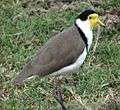 Southern race, V. m. novaehollandiae in Queensland
Southern race, V. m. novaehollandiae in Queensland- Northern race, V. m. miles
 Southern race facial detail. Also shows wing spurs.
Southern race facial detail. Also shows wing spurs.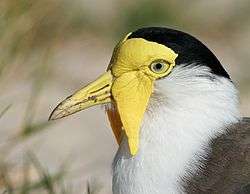 Northern race facial detail.
Northern race facial detail. Young masked lapwing running
Young masked lapwing running Young birds crouch and lie still and are well camouflaged
Young birds crouch and lie still and are well camouflaged
Notes
References
- ↑ BirdLife International (2012). "Vanellus miles". IUCN Red List of Threatened Species. Version 2013.2. International Union for Conservation of Nature. Retrieved 26 November 2013.
- ↑ The Hooded Plover
- 1 2 Boddaert, Pieter (1783). Table des Planches Enluminéez d'Histoire Naturelle de M. D'Aubenton (in French). Utrecht. p. 51, number 835.
- 1 2 Peters, James Lee (1934). Check list of Birds of the World, Volume 2. Cambridge Mass.: Harvard University Press. p. 239.
- ↑ Mathews, G.M. (1912). "A reference-list to the birds of Australia". Novitates Zoologicae. 18 (3): 171–455, in particular page 215.
- ↑ Gill, Frank; Donsker, David (eds.). "Buttonquail, plovers, seedsnipe & sandpipers". World Bird List Version 5.4. International Ornithologists' Union. Retrieved 9 December 2015.
- 1 2 del Hoyo, J.; Collar, N.; Kirwan, G.M. (1996). "Black-shouldered Lapwing (Vanellus novaehollandiae)". In del Hoyo, J.; Elliott, A.; Sargatal, J.; Christie, D.A.; de Juana, E. Handbook of the Birds of the World Alive. Lynx Edicions. Retrieved 10 December 2015.(subscription required)
- 1 2 Wiersma, P.; Kirwan, G.M. (2015). "Masked Lapwing (Vanellus miles)". In del Hoyo, J.; Elliott, A.; Sargatal, J.; Christie, D.A.; de Juana, E. Handbook of the Birds of the World Alive. Lynx Edicions. Retrieved 9 December 2015.(subscription required)
- 1 2 "Masked Lapwing Fact Sheet, Lincoln Park Zoo"
- ↑ "Spur-winged plover". New Zealand Birds Online. Retrieved 10 December 2015.
- ↑ "Masked Lapwings: Managing bird strike risk at Australian airports" (PDF). ATSB Bird Information Sheet No.3. Australian Transport Safety Bureau. Retrieved 13 May 2011.
External links
 Media related to Vanellus miles at Wikimedia Commons
Media related to Vanellus miles at Wikimedia Commons Data related to Vanellus miles at Wikispecies
Data related to Vanellus miles at Wikispecies
